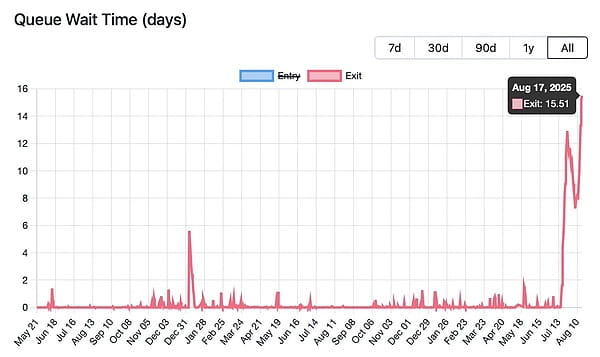Jessy, Golden Finance
Recently, Ethereum experienced a rare wave of unstaking, with over 900,000 ETH queued to exit, waiting to be unlocked, with the longest unlocking wait reaching 16 days. Meanwhile, Ethereum's price has been declining for nearly a week after hitting a peak of $4,789, falling to just above $4,000.

Is the market's concern over the excessive number of Ethereum queued for unlocking what triggered the decline in Ethereum? Why are such large amounts of capital eager to exit? What market logic is hidden behind this?
The chain reaction of 900,000 ETH queued for unstaking
To understand this wave of unstaking, one must first understand Ethereum's PoS mechanism. Since Ethereum transitioned to a PoS mechanism, validators can participate in block production and transaction validation by staking at least 32 ETH. In return, stakers can earn an annual yield of about 2%–4%.
Unlike traditional financial markets, Ethereum's staking mechanism is not always open for entry and exit. To maintain network stability, the Ethereum protocol imposes exit limits: only a limited number of validators are allowed to exit during each epoch (approximately 6.4 minutes). This mechanism ensures that large-scale redemptions do not lead to a sudden drop in network security. However, it also means that when exit demands surge, a 'queue phenomenon' like the current one can occur, lasting over ten days.
The most direct trigger for this unlocking wave actually stems from the abnormal surge in ETH borrowing rates on decentralized finance lending protocols, especially on the Aave platform.
An article from Galaxy Research pointed out that starting from July 14, ETH borrowing rates on the Aave protocol began to soar periodically. While borrowing rates typically range from 2% to 3%, they surged to 18% on July 16, 18, and 21.
This volatility was triggered by a sharp reduction in the supply of ETH on the Aave platform, caused by a wallet associated with the HTX exchange withdrawing large amounts from the platform. Since June 18, this wallet has withdrawn over 167,000 ETH. The sudden decrease in ETH deposits put pressure on users operating ETH circular strategies on the Aave platform and led to a surge in redemption requests.
Under Aave's algorithmic interest rate model, when borrowing demand far exceeds the available supply, the interest rate automatically spikes.
Such drastic changes in interest rates have directly destroyed the 'ETH circular leverage' strategy widely used by many investors. When borrowing costs (18%) far exceed Ethereum's staking yield (about 2.9%), this strategy is no longer a profit amplifier but has turned into a loss machine. Faced with sharply rising capital costs, many traders and institutions employing such strategies were forced to de-leverage, with the only option being to unlock staked ETH to repay high-interest loans. This forced and large-scale liquidation constituted the main body of this exit queue.
Unstaking ≠ Selling; this is not a crisis but a sign of Ethereum's maturity.
However, it is true that some large holders are taking profits. Prior to this, the price of ETH experienced a strong increase, nearly reaching a new high, and many early stakers' locked assets gained significant profits. Choosing to exit near the price peak, unlocking the staked ETH and selling it on the secondary market is a classic operation to lock in profits and realize investment returns. Therefore, a considerable portion of the ETH in the exit queue comes from these long-term investors.
The concentrated liquidation of leveraged strategies triggered a chain reaction in the market, creating an entry opportunity for a third force—arbitrageurs.
When a large number of users rushed to sell liquid staking tokens (such as Lido's stETH) to repay loans, a temporary 'decoupling' occurred between their prices and the underlying asset ETH, providing an opportunity for sharp-eyed arbitrageurs. They bought large amounts of liquid staking tokens at a discount and then redeemed these tokens for ETH at a 1:1 ratio through official channels, thus obtaining risk-free profits. This arbitrage activity undoubtedly further increased the length and scale of the exit queue.
However, it is worth emphasizing that despite the current decline in Ethereum's price due to potential selling pressure, this wave of unlocking is not a signal of crisis. On the contrary, it proves the strong resilience of the Ethereum PoS mechanism and ecosystem. Market participants' behaviors are based on clear economic signals rather than panic. Ethereum's exit mechanism is operating smoothly as designed, orderly handling an unprecedented volume of requests.
This indicates that this is not a crisis, but rather a strong testament to Ethereum's maturation as a decentralized financial economy. An article from Galaxy Research also pointed out that despite large-scale withdrawals, new staking demand remains strong, nearly offsetting the impact of the withdrawals. This shows that the market is still confident in Ethereum's long-term prospects.

